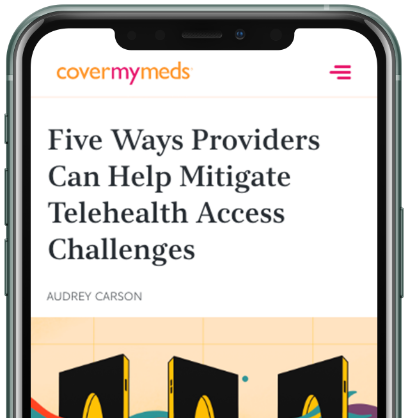Patient Decisions and the Impact of Real-Time Benefit Check
Patients are increasingly paying more for medical care, contributing to the rise of healthcare consumerism. A 2018 survey conducted by CoverMyMeds found that 87 percent of respondents said it'd be valuable if providers could share the cost of medications during the appointment.

Real-time benefit check (RTBC) is an emerging technology that can help improve drug price transparency and medication adherence. RTBC assists providers and patients by surfacing prescription benefit details at the point of prescribing, empowering patients with information like out-of-pocket costs, prior authorization requirements, formulary alternatives, deductible remaining, the pharmacy pick-up process and patient assistance programs.
During a July 25 webinar sponsored by CoverMyMeds and hosted by Becker's Hospital Review, Jordan Hilsher, a CoverMyMeds sales engineer, and Brian Kolligian, CoverMyMeds provider solutions consultant, discussed the importance of price transparency, the advantages of introducing a RTBC solution for both providers and patients and factors that drive patient decisions on medication.
Four factors influencing patient decisions
Hilsher discussed the four most significant factors he believes are driving patient decisions regarding medication:
Affordability: According to the CoverMyMeds survey, in 2018, the average American family of four with insurance through their employer spent over $12,000 on premiums and out-of-pocket costs, with the median household income recorded as $61,000 per year. "This tells us that the average American household in 2018 was spending roughly 20 percent of their annual income on healthcare," Hilsher said. "That's pretty eye-opening … this creates [a huge burden] for families financially."
Quality: This is the driving force for patients who always opt for the latest and greatest medications, such as patients who refuse to price shop and regularly choose branded medications over generic labels.
Time: Patients with a debilitating diagnosis are usually focused on getting whatever treatment is necessary as quickly as possible to help them feel better. "When patients encounter moments like this, their health decisions are dictated by how quickly they can get access to treatment," Hilsher said.
Convenience: In terms of patient choice and healthcare consumerism, convenience plays a significant role in patient decisions regarding medication. To some, spending extra money to pick up medications at a pharmacy closer to home is worthwhile when they consider the time saved.
Benefits of RTBC for providers and patients
Surfacing prescription benefit details via RTBC enables timely discussions about clinically appropriate and affordable medications. This allows providers to prescribe suitable alternative medications, which can increase the likelihood of a patient adhering to their healthcare plan.
"By allowing [patients] to have access to tools such as a RTBC solution, they have the ability to be informed about what medications they're on, how much it may cost and having an idea of what a visit to the doctor or pharmacy is going to cost," Kolligian said. "By proactively being able to manage their own savings, patients can use the same tools to get that information ahead of time about how much it may cost to get that medication."
To learn more about a real-time benefit check solution, watch a replay of the webinar.
The latest healthcare insights, floated right to your inbox.



